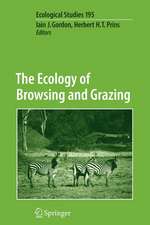Zooarchaeology and Modern Human Origins: Human Hunting Behavior during the Later Pleistocene: Vertebrate Paleobiology and Paleoanthropology
Editat de Jamie L. Clark, John D. Spethen Limba Engleză Hardback – 24 iul 2013
| Toate formatele și edițiile | Preț | Express |
|---|---|---|
| Paperback (1) | 648.89 lei 43-57 zile | |
| SPRINGER NETHERLANDS – 9 aug 2015 | 648.89 lei 43-57 zile | |
| Hardback (1) | 604.46 lei 38-44 zile | |
| SPRINGER NETHERLANDS – 24 iul 2013 | 604.46 lei 38-44 zile |
Din seria Vertebrate Paleobiology and Paleoanthropology
- 15%
 Preț: 717.13 lei
Preț: 717.13 lei -
 Preț: 314.69 lei
Preț: 314.69 lei - 15%
 Preț: 724.12 lei
Preț: 724.12 lei - 18%
 Preț: 738.34 lei
Preț: 738.34 lei - 18%
 Preț: 741.37 lei
Preț: 741.37 lei - 15%
 Preț: 719.39 lei
Preț: 719.39 lei - 18%
 Preț: 635.91 lei
Preț: 635.91 lei -
 Preț: 411.04 lei
Preț: 411.04 lei - 20%
 Preț: 606.45 lei
Preț: 606.45 lei -
 Preț: 392.60 lei
Preț: 392.60 lei - 20%
 Preț: 617.47 lei
Preț: 617.47 lei - 15%
 Preț: 650.19 lei
Preț: 650.19 lei -
 Preț: 397.38 lei
Preț: 397.38 lei - 20%
 Preț: 619.35 lei
Preț: 619.35 lei -
 Preț: 391.27 lei
Preț: 391.27 lei -
 Preț: 431.73 lei
Preț: 431.73 lei -
 Preț: 433.47 lei
Preț: 433.47 lei - 24%
 Preț: 715.31 lei
Preț: 715.31 lei -
 Preț: 449.63 lei
Preț: 449.63 lei - 24%
 Preț: 763.00 lei
Preț: 763.00 lei - 15%
 Preț: 715.31 lei
Preț: 715.31 lei - 24%
 Preț: 636.37 lei
Preț: 636.37 lei - 20%
 Preț: 631.45 lei
Preț: 631.45 lei - 18%
 Preț: 792.19 lei
Preț: 792.19 lei -
 Preț: 380.72 lei
Preț: 380.72 lei - 15%
 Preț: 708.75 lei
Preț: 708.75 lei -
 Preț: 404.29 lei
Preț: 404.29 lei - 24%
 Preț: 645.20 lei
Preț: 645.20 lei -
 Preț: 383.95 lei
Preț: 383.95 lei - 18%
 Preț: 898.13 lei
Preț: 898.13 lei -
 Preț: 403.75 lei
Preț: 403.75 lei
Preț: 604.46 lei
Preț vechi: 755.58 lei
-20% Nou
Puncte Express: 907
Preț estimativ în valută:
115.70€ • 125.72$ • 97.25£
115.70€ • 125.72$ • 97.25£
Carte tipărită la comandă
Livrare economică 16-22 aprilie
Preluare comenzi: 021 569.72.76
Specificații
ISBN-13: 9789400767652
ISBN-10: 940076765X
Pagini: 190
Ilustrații: XI, 275 p. 82 illus., 50 illus. in color.
Dimensiuni: 210 x 279 x 23 mm
Greutate: 1.13 kg
Ediția:2013
Editura: SPRINGER NETHERLANDS
Colecția Springer
Seria Vertebrate Paleobiology and Paleoanthropology
Locul publicării:Dordrecht, Netherlands
ISBN-10: 940076765X
Pagini: 190
Ilustrații: XI, 275 p. 82 illus., 50 illus. in color.
Dimensiuni: 210 x 279 x 23 mm
Greutate: 1.13 kg
Ediția:2013
Editura: SPRINGER NETHERLANDS
Colecția Springer
Seria Vertebrate Paleobiology and Paleoanthropology
Locul publicării:Dordrecht, Netherlands
Public țintă
ResearchCuprins
1. Introduction.- 2. Exploring the Relationship Between Climate Change and the Decline of the Howieson’s Poort at Sibudu Cave (South Africa).- 3. Middle Paleolithic Large-Mammal Hunting in the Southern Levant.- 4. Middle Paleolithic Prey Choice Inferred from a Natural Pitfall Trap.- 5. New Opportunities for Previously Excavated Sites.- 6. New Contributions on Subsistence Practices during the Middle-Upper Paleolithic in Northern Spain.- 7. Iberian Archaeofaunas and Hominin Subsistence During Marine Isotope Stages 4 and 3.- 8. Animal Exploitation Strategies During the Uluzzian at Grotta di Fumane (Verona, Italy).- 9. A Diachronic Evaluation of Neanderthal Cervid Exploitation and Site Use at Pech de l’Azé IV, France.- 10. Neanderthal to Neanderthal Evolution.- 11. The Role of Fish, Fowl and Small Mammals in the Fauna of the Paleolithic Caves of the Swabian Jura, Southwestern Germany.- 12. Neanderthals and Cave Hyenas.- 13. Bone Grease Rendering in Mousterian Contexts.- 14. Foraging Goals and Transport Decisions in Western Europe During the Paleolithic and Early Holocene.
Notă biografică
Jamie L. Clark is an Assistant Professor of Anthropology at the University of Alaska Fairbanks. She is also an Honorary Research Fellow at the Institute for Human Evolution, University of the Witwatersrand (Johannesburg, South Africa), and a research fellow at the Institut für Naturwissenschaftliche Archäologiem, Universität Tübingen (Germany). She received her BA in African and Middle Eastern History from Northwestern University (2002) and her MA (2004) and PhD (2009) in Anthropology (Archaeology) from the University of Michigan.
John D. Speth is Arthur F. Thurnau Professor Emeritus of Anthropology in the Department of Anthropology at the University of Michigan (Ann Arbor). He served as Director of the Museum of Anthropology from 1986 to 1989 and as the Museum’s Associate Director from 2006 to 2008. Dr. Speth completed his BA in Geology at the University of New Mexico (1965), and his MA (1968) and PhD (1971) in Anthropology at the University of Michigan. Dr. Speth studies hunter-gatherers, past and present, New World and Old World.
John D. Speth is Arthur F. Thurnau Professor Emeritus of Anthropology in the Department of Anthropology at the University of Michigan (Ann Arbor). He served as Director of the Museum of Anthropology from 1986 to 1989 and as the Museum’s Associate Director from 2006 to 2008. Dr. Speth completed his BA in Geology at the University of New Mexico (1965), and his MA (1968) and PhD (1971) in Anthropology at the University of Michigan. Dr. Speth studies hunter-gatherers, past and present, New World and Old World.
Textul de pe ultima copertă
Recent genetic data showing that Neanderthals interbred with modern humans have made it clear that deeper insight into the behavioral differences between these populations will be critical to understanding the rapid spread of modern humans and the demise of the Neanderthals. This volume, which brings together scholars who have worked with faunal assemblages from Europe, the Near East, and Africa, makes an important contribution to our broader understanding of Neanderthal extinction and modern human origins through its focus on variability in human hunting behavior between 70-25,000 years ago—a critical period in the later evolution of our species.
Caracteristici
New data that helps gain deeper insight into potential behavioural difference between Neanderthals and early modern humans ? Explores nature and range of variability in human hunting behaviour during MIS 3 and 4 Addresses implications of this for broader understanding of Neanderthal extinction and modern human origins Direct comparisons between late Middle and early Upper Paleolithic assemblages Includes supplementary material: sn.pub/extras














